 |
 |
 |
http://www.varalaaru.com A Monthly Web Magazine for South Asian History [187 Issues] [1839 Articles] |
 |
 |
 |
http://www.varalaaru.com A Monthly Web Magazine for South Asian History [187 Issues] [1839 Articles] |
|
Issue No. 58
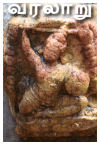
இதழ் 58 [ ஏப்ரல் 26 - மே 20, 2009 ] 
இந்த இதழில்.. In this Issue.. 
|
Series:
Pudukkottai Cave Temples
The inner mandapa leads us to the rockcut cave of Satyagiriswara which is to its northern side. The cave consists of a facade, mukhamandapa and a sanctum. The mandapa faces south whereas the sanctum which is on the western lateral wall faces east. 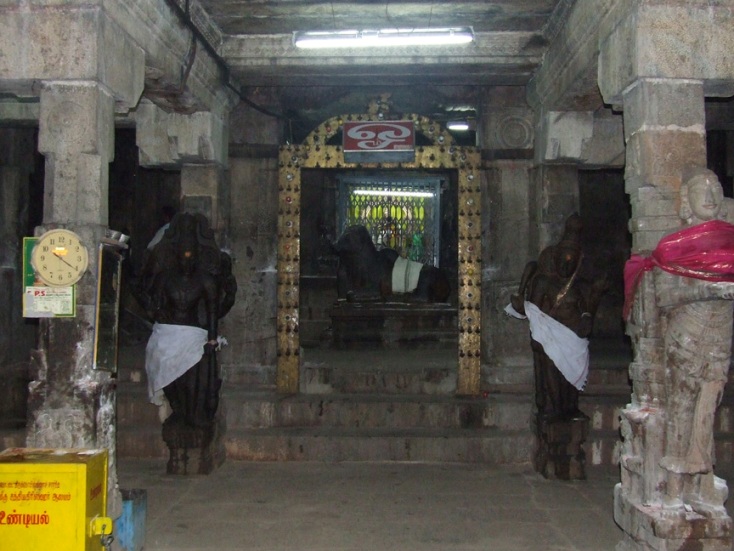 THE PASSAGE LEADING TO THE CAVE FROM INNER MANDAPA Both the Sathyagiriswara and Sathyamoorthy rockcut caves lie on the southern precipice of the hillock. The hillock on its southern side has a recession in the foot and in the upper level it has a brow like extension that forms a natural awning to the caves. 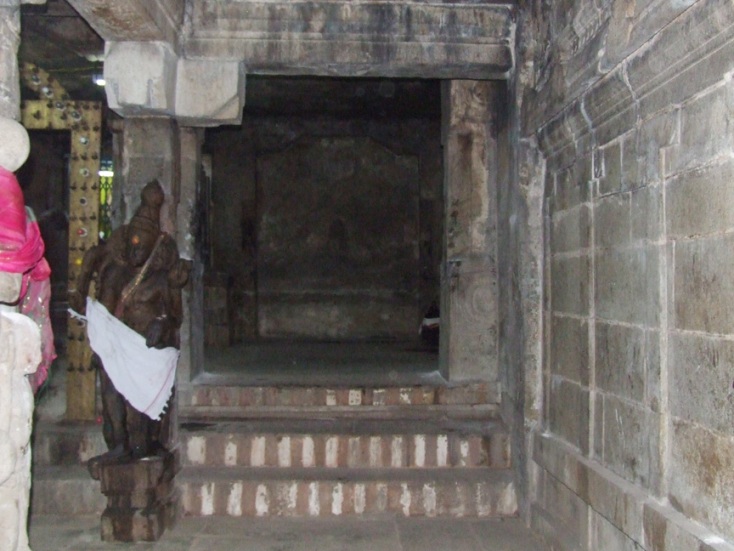 THE EASTERN SIDE OF THE CAVE The cave of Sathyagiriswara is hewn to a height of .72mts from the ground level of inner mandapa. The raised portion is shown as a adhisthana. A flight of two arranged steps, which is of later origin, veiled not only the raised portion of the facade but also the inscription in the kanda and pattika portion. The length of the cave in east west direction that is in between the eastern and western side walls is 7.67mts. and in north south direction it 4.81mts. The facade is 6.49mts in east west direction and .68mts in the north south direction. As usual the facade consists of two colossal pillars in the middle and two pilasters on the corners. The width of the anganas is almost equal with 1.90mts. The extension of the facade towards south on the eastern side is 1.14 mts and on the western side is 1.06 mts, which are occupied by inscriptions on both sides. The rough rock brow forms the kapota, which in front is concealed by the roof of the inner mandapa. The canopy of the kapota is flat.  THE INSCRIPTION ON THE SOUTHERN PRECIPICE OF THE HILLOCK To the west of the rockcut cave a lengthy inscription is inscribed on the southern precipice of the hillock. The inscription speaks about the settlement of the dispute between the saivas and the vaishnavas arrived at in a great assembly consisting of the residents of the districts, cities and villages of Virudurajabhayankara valanadu, samayamantrins, araiyars etc. under the presidentship of Appanna Dandanayaka who was one of the Dandanayakas of Hoysala king Vira Somisvaradeva. The same inscription is also found on the rock to the north of the tank in the same temple. A beam is running across the facade in east west direction adjoining the kapota which is of later addition. Two pillars that are placed inside the mandapa in front of the facade support it. The sculptures of the dvarapalas are plastered to these pillars. 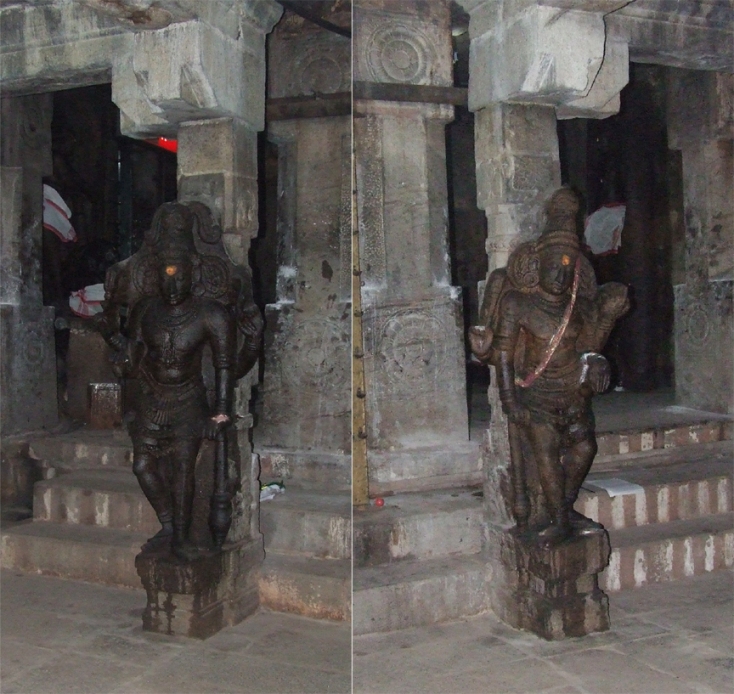 THE DVARAPALAKAS IN FRONT OF THE CAVE Both the dvarapalas are standing with their legs twisted in opposite direction in tirayachara. Their head is decorated as jatamakuta, ears are adorned with patrakundalas, a pendant like ornament and necklaces adorns their neck. Armlets, anklets, and bangles are the other ornaments found. The dvarapala in the right is holding a trident in the right backhand and a snake in the right backhand whereas the front right hand is in darjani mudra and the left front hand is resting on the plank. The dvarapala in the left is holding trident in the right backhand and the left hand is in vismaya. The front right hand is holding the plank and the left hand is in resting posture. The two dvarapalakas flank the entrance and leads us to the rock cut cave. 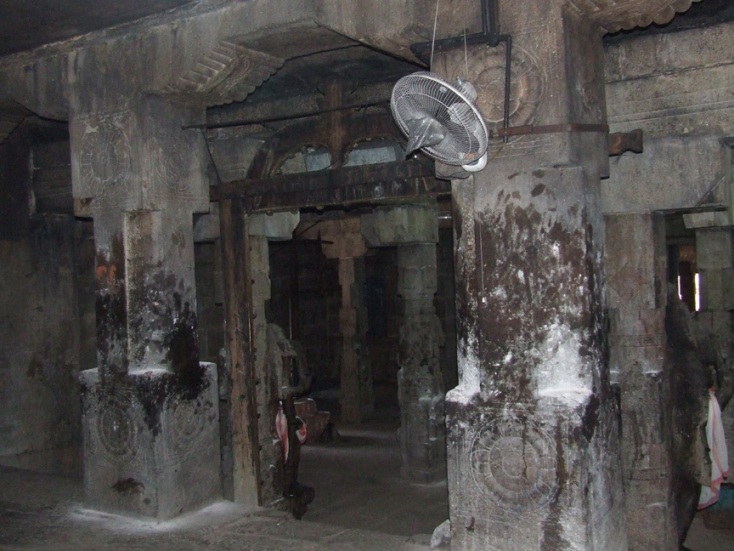 THE PILLARS IN THE FACADE The facade is decorated with two pillars in the middle and two pilasters each one on the corners. The colossal pillars in the facade are styled as squares on both ends and with a kattu in the middle. Comparing to the upper square the lower square is little higher in nature. Both in the upper and the lower squares the faces are adorned with circular medallions carved inside a square frame. It is an interesting feature to note that the lotus flower is shown in various stages in the medallions. In some faces a blossom with two whorls are shown in which the inner as closed and outer as bloomed. In the eastern middle pillar a blossom of three whorls is shown. The western pillar and pilaster is decked with lotus bud. In some faces four half bloomed flower is arranged inside the circle whereas in some faces six half bloomed flowers are arranged inside the circle. In between the half bloomed flowers buds are shown interlaced. The pilasters also possess the same features.  THE LOTUS MEDALLIONS IN THE SQUARE FACES Above the pillars and pilasters rest the potikas, which are slender with taranga and patta. Three wavy arches are formed in the linear section and five in the angular section. Reverse wavy contours are shown above the tarangas in the linear section. The potikas bears the uttira and a thin vajana, running in the roof. The central band in the potikas possess scroll with leaf like pattern in it. 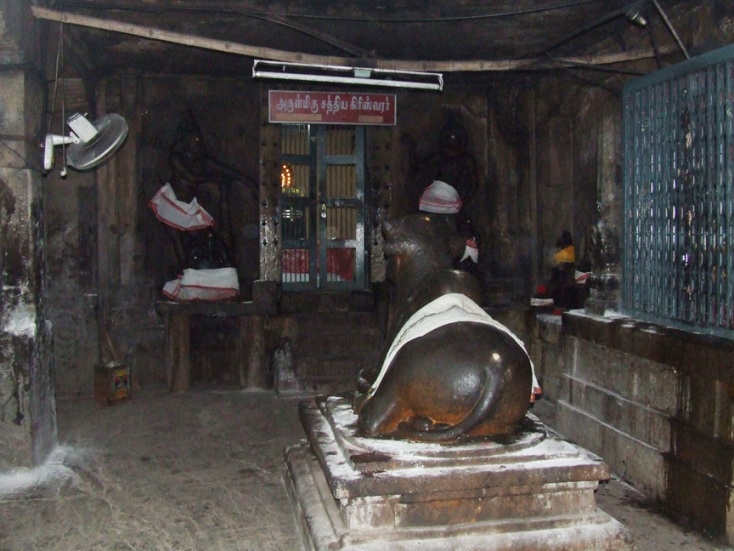 THE VIEW OF THE CAVE INSIDE THE MANDAPA A flight of two steps leads us to the south facing mukhamandapa. The pattika forms the floor of the mandapa. The sanctum is seen in the western lateral wall. The mandapa measures 4.19mts in north south direction and 8.37mts in east west direction. The eastern lateral wall of the mandapa is occupied by a huge lingodhbava bas relief sculpture. The western lateral wall gives room for the sanctum. The northern wall of the mandapa is sectioned as three niches with pilasters. Vajana is running throughout the mandapa. In the center of the mandapa is seen a huge nandi facing the presiding deity. 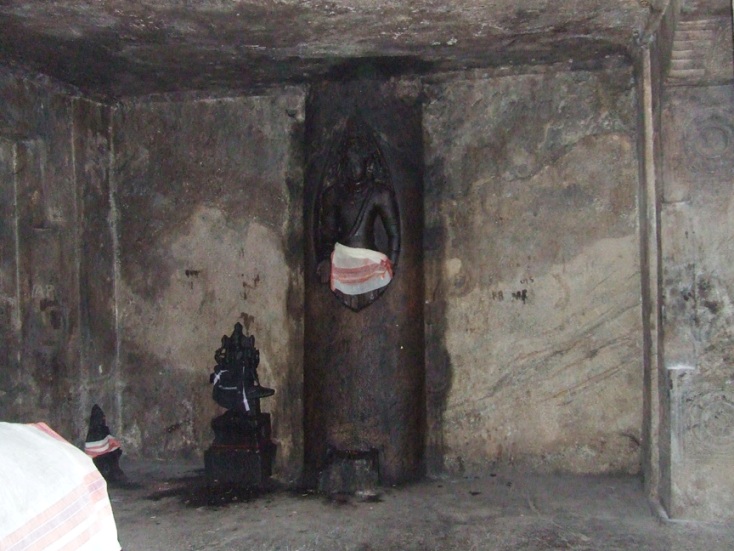 THE LINGODHBAVA IN THE EASTERN LATERAL WALL The lingodhbava is shown touching the roof and the floor of the mandapa. The bana is .90 mts width and extends .26mts inside the mandapa. Inside the bana is God Siva shown upto the waist in standing posture. His head decorated as jatamakuta and the free floating tresses are curled in the edges. Earlobes are elongated and decked with makara kundalas. Charapali and a beaded mala adorns his neck. Udarabanda, armlets and bangles are the ornaments found. A garland like yajnopavita is worn in niveta style. The yappu is seen around the waist and the idaikattu is in two rows with knot on the left. Fire flames are shown at equal intervals on either side of the bana each side four in numbers. A small square shaped rock cut palithala is seen at the foot of the bana. The palithala adjoining the bana measures .23mts height and .37mts in north south and .30mts in east west direction. Both the interior and posterior pilasters are formed on the eastern side by leaving a space of .44 mts in the north and .56 mts in the south. 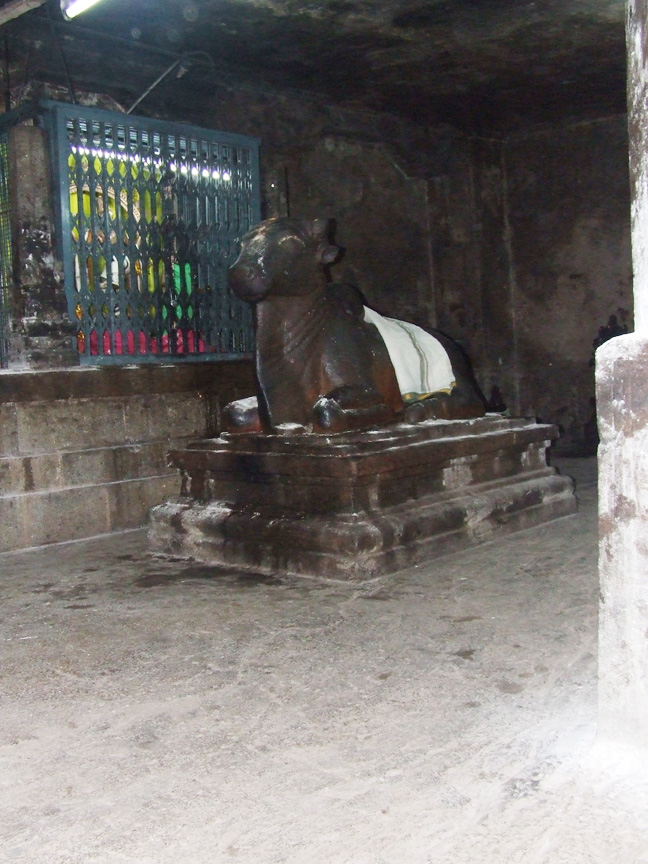 THE ROCK CUT NANDI IN THE CENTER OF THE MANDAPA In the middle of the mandapa is seen a seated nandi on a platform facing west. The entire structure is made of mother rock and it elevates to a height of 1.51mts from the ground. The pedestal extends 1.61mts in east west and 1.15mts in north south direction and a height of 0.55mts. It has a padabandha adhisthana which starts from jagadi and ends with uparikambu. The uparikambu is shown in two layers, the lower stratum as oblong shape and the upper stratum as elliptical. 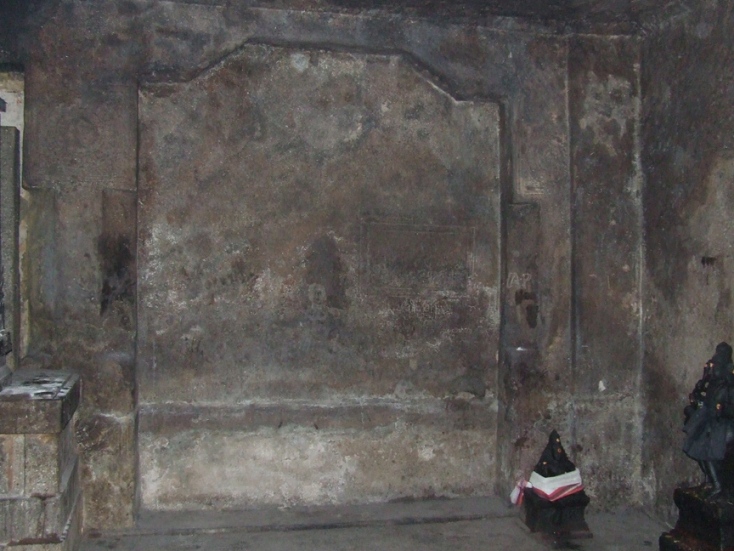 THE HIND WALL SECTIONED AS A NICHE IN THE EAST The northern wall of the mandapa is sectioned as three niches with four pilasters. The pilasters possess the same features as like the pillars and pilasters of the facade. The potikas are taranga and bears the uttira and vajana. The thin vajana is running through out the mandapa and adjoins the roof. A raised floor level to the extension of .29 mts and 1 inch height is shown for the entire stretch of the hind wall pilasters. The eastern niche is 2.16mts in width and the western niche is 1.97mts. Both on the western and the middle niches platform is formed to place sculptures. The bronze sculptures of Nataraja with his consort to his left and Appar to his right are kept in the middle niche enclosed by grill gate. As like the eastern side, in the west also a space of .43 mts is left in the northern wall and the western end pilaster is formed. On the eastern niche a Tamil inscription and the “Parivadinidha” inscription is seen. 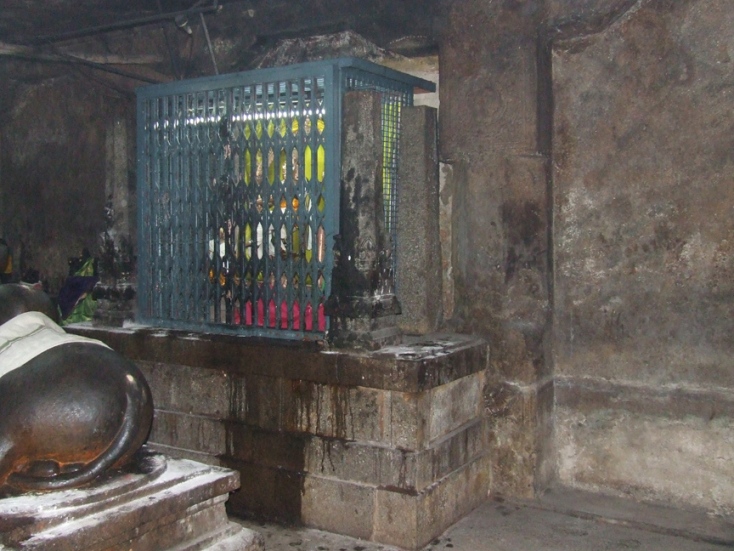 THE MIDDLE NICHE Loose sculptures are seen in the mandapa. On the platform in the western niche sculptures of Goddess, Ganesa, Bairava and a saint are seen. Sanibahavan, Bairava are seen near lingothbava. Traces of paintings are seen on the central part of the ceiling of the mandapa.  THE PAINTINGS IN THE CEILING 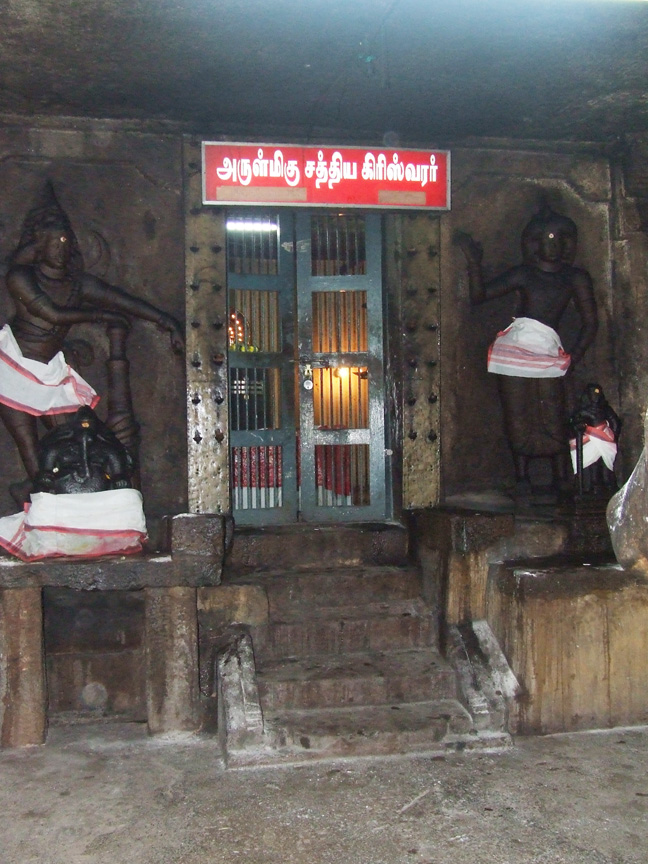 THE FRONT VIEW OF THE SANCTUM The sanctum is hewn on the western side of the cave facing east. The western lateral wall of the mandapa, which forms the front wall of the sanctum, is shown with a basement and a wall. The adhisthana is concealed by a later addition on the northern side and on the southern side also it is only partially visible. The padabanda adhisthana with the features of jagadi, rudra kumuda, kandapada and pattika are seen. Above the pattika raises the wall sectioned by four pilasters. The pilasters are squares at ends and a kattu in the middle. It is a rare feature to note that the pilasters of the sanctum wall shown with squares and kattu. The Vishnu kattu is shown as a long shaft with small squares at the ends. The squares that face the mandapa are adorned with medallions. Above the pillars are the potikas of taranga type with the reverse contour for the middle wave. Another feature to note is the potika extending inside the mandapa. The potikas holds the uttira and above it is the vajana, which is the buffer between the roof and the wall. 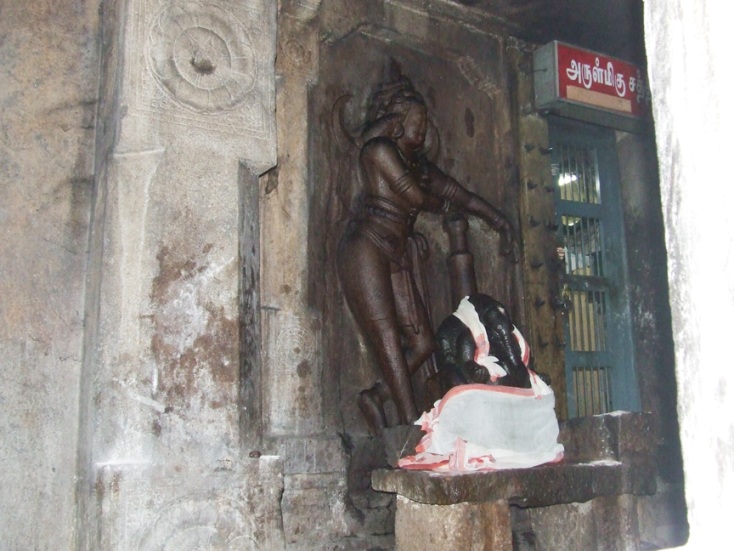 THE THIRUSULADEVA The space between the pilasters on either side of the wall forms a niche whereas in the middle it flanks the entrance to the sanctum. The niches houses Tirisuladeva in south and Mazhuvadiyar in the north. Metal plates cover the pilasters that flank the entrance. The pattika of the adhisthana forms the platform for Tirisuladeva. He is standing in swastika with his right leg in tirayachara and the left leg in agratalasanjara. He is wearing a half dress with waist belt. The waist belt is fastened through the loop in the center clip forming a knot and hangs on the left thigh. He is wearing a heavy waist ornament with two strings holding the pendant. Idaikattu is absent instead he is wearing a vastira utarabanda with knot on the left side and its bow shown flowing behind him. The yajnopavita with flowers is worn in upavita style. The ornaments are heavy and stone studded. Charapali, bangles, armlets and patrakundala are the ornaments found. Jatabara with headgear adorns his head. The sula is shown behind him near his shoulders. A ring is seen in the right hand small finger. The right hand is holding a snake coiled heavy plank that is placed to his left, and the left hand is stretched over the right hand in gajamudra. He stands elegantly by slightly leaning towards left by resting the body weight on the plank. Thick mustaches, raised eyebrows and a mild smile add grace to his face. 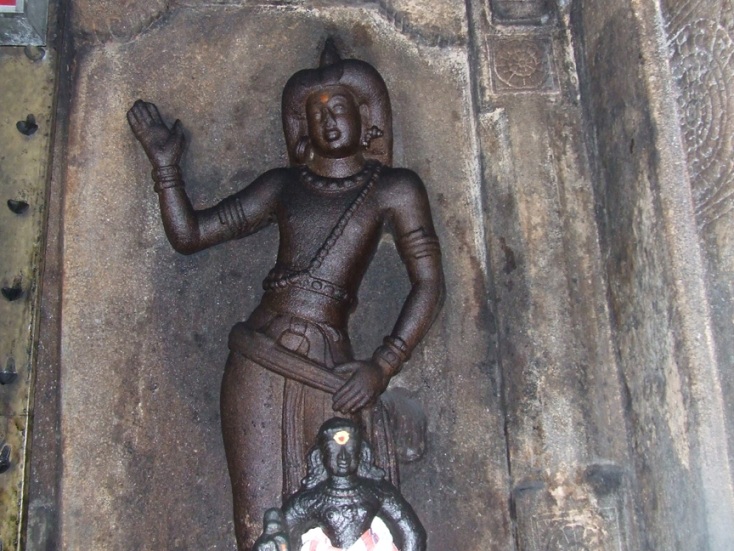 THE MAZHUVADIYAR The mazhuvadiyar is seen on the northern side niche. He is standing on a small platform above the pattika. Both the legs are in tirayachara. The head is decorated as jatabara with axe in the center and the right ear is adorned with patrakundala and the left ear is adorned with pootukundala. Neck is decked with stone studded charapalli and a beaded yajnopavita is worn in upavita style. Udarabanda, armlets, bangles and charapalli are the other ornaments worn by him. Except armlets all the other ornaments are stone studded. A small ring is shown in his right small finger. He is wearing a heavy dress floating below his knee. A tuft of the dress is gathered in the center and fastened with the waist belt. The belt running through the loop forms a bow in the center and hangs on the left thigh. The idaikattu is shown with its knot hanging on the left. The left hand is holding the idaikattu whereas the right hand is eulogizing the God. Both the dvarapalas resembles the dvarapalas of Kundrandarkoil. 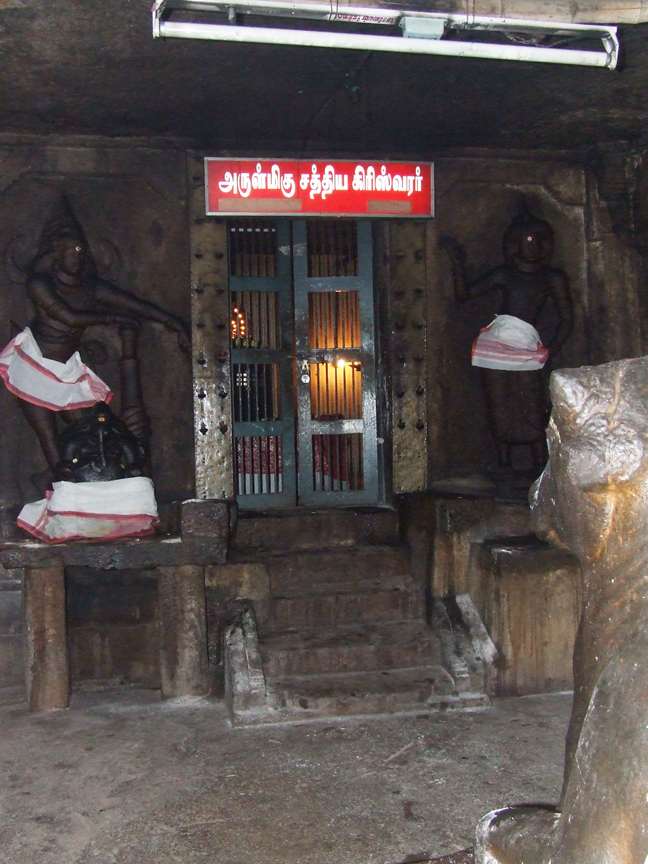 THE SANCTUM FRONT VIEW Five rock cut steps leads us to the sanctum. The lowest step forms the chandrakal. The parapet walls are seen on either side with scroll at the ends. The sanctum is a cubical room with the rock cut linga in the center. The komukha of the linga is very small supported by a rampant lion. The unique thing to speak about this rockcut cave is the arrangement of the cave. The sanctum and the bas-relief sculpture occupying the lateral walls and the rear wall of the mandapa decorated as three niches. This style of arrangement is found in both the upper and the lower rock cut caves of Thiruchirappalli which belongs to the Pallava period. The earliest known authored inscription of this cave belongs to 13th century AD but the presence of the 'Parivadinida' inscription repulses the age of the cave further back. Hence on the basis of epigraphical and architectural style we can fix the age of the cave between the fourth quarter of the seventh century AD to the second quarter of the eighth century AD. Thus we can substantiate it as one of the earliest cave of Tamilnadu. this is txt file� |

சிறப்பிதழ்கள் Special Issues 

புகைப்படத் தொகுப்பு Photo Gallery 
|
| (C) 2004, varalaaru.com. All articles are copyrighted to respective authors. Unauthorized reproduction of any article, image or audio/video contents published here, without the prior approval of the authors or varalaaru.com are strictly prohibited. | ||